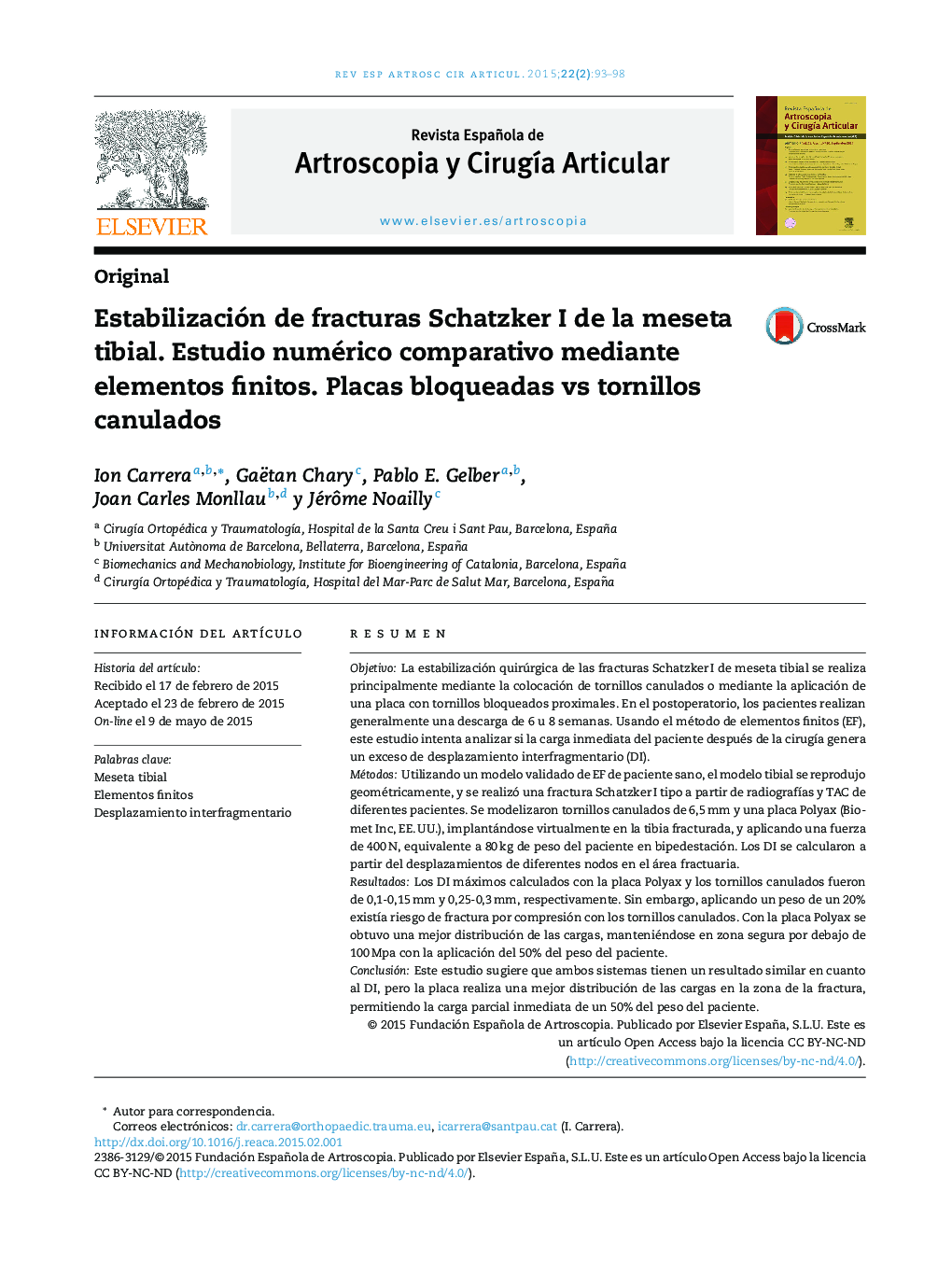| Article ID | Journal | Published Year | Pages | File Type |
|---|---|---|---|---|
| 4305985 | Revista Española de Artroscopia y Cirugía Articular | 2015 | 6 Pages |
ResumenObjetivoLa estabilización quirúrgica de las fracturas Schatzker I de meseta tibial se realiza principalmente mediante la colocación de tornillos canulados o mediante la aplicación de una placa con tornillos bloqueados proximales. En el postoperatorio, los pacientes realizan generalmente una descarga de 6 u 8 semanas. Usando el método de elementos finitos (EF), este estudio intenta analizar si la carga inmediata del paciente después de la cirugía genera un exceso de desplazamiento interfragmentario (DI).MétodosUtilizando un modelo validado de EF de paciente sano, el modelo tibial se reprodujo geométricamente, y se realizó una fractura Schatzker I tipo a partir de radiografías y TAC de diferentes pacientes. Se modelizaron tornillos canulados de 6,5 mm y una placa Polyax (Biomet Inc, EE. UU.), implantándose virtualmente en la tibia fracturada, y aplicando una fuerza de 400 N, equivalente a 80 kg de peso del paciente en bipedestación. Los DI se calcularon a partir del desplazamientos de diferentes nodos en el área fractuaria.ResultadosLos DI máximos calculados con la placa Polyax y los tornillos canulados fueron de 0,1-0,15 mm y 0,25-0,3 mm, respectivamente. Sin embargo, aplicando un peso de un 20% existía riesgo de fractura por compresión con los tornillos canulados. Con la placa Polyax se obtuvo una mejor distribución de las cargas, manteniéndose en zona segura por debajo de 100 Mpa con la aplicación del 50% del peso del paciente.ConclusiónEste estudio sugiere que ambos sistemas tienen un resultado similar en cuanto al DI, pero la placa realiza una mejor distribución de las cargas en la zona de la fractura, permitiendo la carga parcial inmediata de un 50% del peso del paciente.
ObjectiveSurgical stabilization of split fractures of the lateral tibial plateau may involve percutaneous insertion of cannulated screws or more invasive implantation of locked plating systems. In any case, six to eight weeks of non-weight-bearing are recommended. By using the finite element (FE) method, this study aimed to assess whether immediate weight bearing can generate excessive interfragmentary motions (IM).MethodsA validated femur-tibia FE model of a healthy patient was used. The tibia model was reconverted into geometry, and a Schatzker I fracture was re-created based on patient x-rays. Cannulated 6.5 mm cancellous bone screws, and a Polyax tibial locked plating system (Biomet Inc, USA) were modelled, and virtually implanted into the fractured tibia geometry. An axial force of 400 N pressed the femur model against the tibial plateau, simulating the weight of an 80 Kg patient in bipedal stance. IM were calculated as the displacements between two nodes initially superimposed in the fracture areaResultsMaximum IM calculated with the Polyax and with the cannulated screw fixations were around 0.1-0.15 mm, and 0.25-0.3 mm, respectively. Both systems led to similar IM up to 80-90% of applied body weight. However, applying over 20% of the simulated body weight might lead to a risk of compression bone fracture. With the Polyax system, bone stresses were better distributed, and remained below 100 MPa at 30% of body weight. Maximum stresses in the implants were about half the reported strength for the alloy simulated.ConclusionThis study suggested that IM caused by weight bearing might not impede bone healing in a fracture stabilized with either a Polyax locked plating system or cannulated screws. However, cannulated screw systems could lead to harmful load concentrations in the bone with immediate weight bearing. Plate systems will allow around 50% of immediate weight bearing.
